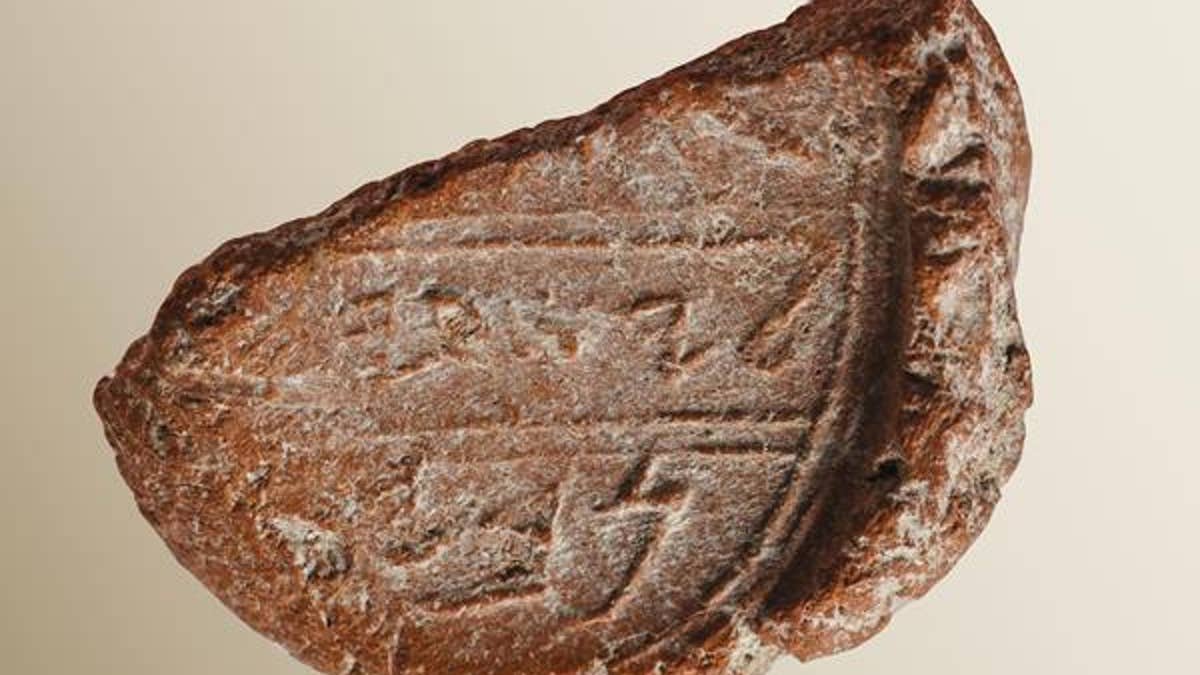
The seal mark discovered in Jerusalem (Eilat Mazar/Biblical Archaeological Society)
Archaeologists in Israel say that they have found a clay seal mark that may bear the signature of the Biblical Prophet Isaiah.
The 2,700-year-old stamped clay artifact was found during an excavation at the foot of the southern wall of Jerusalem’s Temple Mount. In ancient times a seal stamp, or bulla, was used to authenticate documents or items.
“We found the eighth-century B.C.E. seal mark that may have been made by the prophet Isaiah himself only 10 feet away from where we earlier discovered the highly-publicized bulla of King Hezekiah of Judah," said Dr. Eilat Mazar of the Hebrew University in Jerusalem, in a statement.
MYSTERIOUS POOL AND FOUNTAIN DISCOVERED AT ANCIENT CHRISTIAN SITE IN ISRAEL
Dr. Mazar led the team that the found the seal mark linked to the Biblical prophet. The artifact was found among undisturbed Iron Age remains outside an ancient royal bakery.

Stained glass window depicting the prophet Isaiah in the cathedral of Dinant, Belgium. (iStock) (Jorisvo)
The half-inch wide oval-shaped piece of clay is inscribed with the name Yesha’yah[u] (Isaiah) in ancient Hebrew script. This is followed by the word nvy, the end of which is slightly damaged. As a result, experts do not know whether the word ended with the Hebrew letter aleph. That letter “would have resulted in the Hebrew word for ‘prophet’ and would have definitively identified the seal as the signature of the prophet Isaiah,” explained Dr. Mazar. “The absence of this final letter, however, requires that we leave open the possibility that it could just be the name Navi.”
“The name of Isaiah, however, is clear,” she added.
DRONE FINDS MYSTERIOUS ANCIENT STRUCTURE AT ISRAELI MILITARY TRAINING GROUND
Isaiah’s close relationship with King Hezekiah is described in the Bible’s Second Book of Kings.
“If it is the case that this bulla is indeed that of the prophet Isaiah, then it should not come as a surprise to discover this bulla next to one bearing King Hezekiah’s name given the symbiotic relationship of the prophet Isaiah and King Hezekiah described in the Bible,” said Dr. Mazar.
The seal mark is just the latest fascinating archaeological in Israel. Earlier this month, for example, experts revealed that they had uncovered a rare multicolored Roman mosaic featuring three toga-wearing figures during excavations in the ancient city of Caesarea.
ANCIENT INSCRIPTION UNEARTHED IN JERUSALEM, THRILLING ARCHAEOLOGISTS
In January, archaeologists announced the discovery of a large 1,500-year-old pool and elaborate fountain at the site of an ancient church near Jerusalem.
Last November, new evidence dated Christ’s tomb in Jerusalem’s Church of the Holy Sepulchre to the Roman era, matching historical records.
Archaeologists also uncovered a stunning 1,500-year-old Christian mosaic in the ancient Mediterranean coastal city of Ashdod-Yam, now part of the modern city of Ashdod.
LOST ROMAN CITY THAT WAS HOME TO JESUS' APOSTLES FOUND, SAY ARCHAEOLOGISTS
Other finds include the skeleton of a pregnant woman, dating back 3,200 years, in Israel’s Timna Valley, at a place once called King Solomon’s Mines.
In October 2017, archaeologists in Jerusalem announced that they have uncovered a new section of the Western Wall that has been hidden for 1,700 years.
Also in 2017 an ancient Greek inscription was found on a 1,500-year-old mosaic floor near the Damascus Gate in the Old City of Jerusalem.
Some experts also believe they have found the lost Roman city of Julias, formerly the village of Bethsaida, which was the home of Jesus' apostles Peter, Andrew and Philip.
A paper describing the discovery of the ancient seal that may be linked to the Prophet Isaiah has been published in the Biblical Archaeology Review.
Follow James Rogers on Twitter @jamesjrogers




















